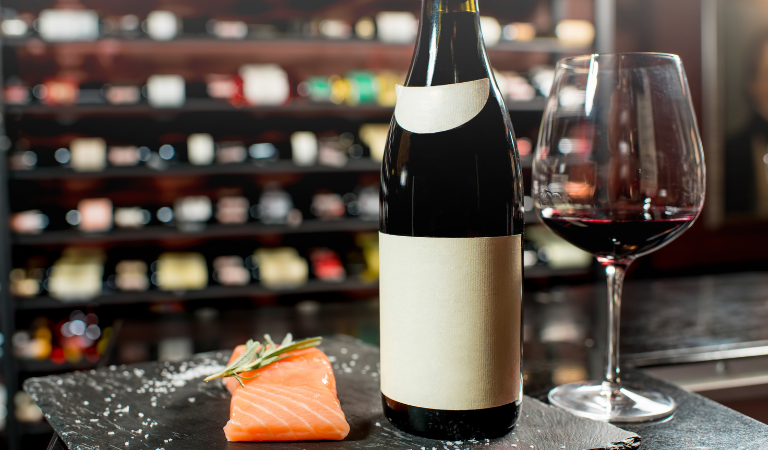When it comes to wine, there are a few things you need to consider to ensure you're pairing the right kind with meals. You don't want the wine to be too sweet or too bitter for the dish you’re serving it with - it needs to be just right. In this detailed guide, we break down how to pair wine with food so that you can provide your customers with the right suggestions.
The Basics Of Pairing Wine With Food
There are a few things that you need to take into account when pairing wine with food. The first is the weight of the dish. You want to match the body of the wine to the weight of the food. For example, a light dish would go well with a light wine like a pinot grigio. Conversely, a heavier dish would go better with a full-bodied wine like a cabernet sauvignon.
The next thing to consider is the flavor of the dish. You want to find a wine that complements the flavors, not competes with them. If you're serving a dish with bold flavors, choose a wine with bolder flavors to match. On the other hand, if you're serving a delicate dish, consider a wine with more subtle flavors.
You also need to take into account the texture of the dish. You want to find a wine that will contrast the texture of the food. For instance, if you're serving a creamy dish, you'll want a wine with more acidity to balance out the creaminess. 
Pairing Wine With Appetizers
When it comes to wine and appetizers, there are a few things to keep in mind. You want to make sure the wine is not too overpowering, or else it will overshadow the flavors of the food. There are a few classic wine and appetizer pairings that always seem to work well together. For example, many people enjoy pairing a dry white wine with a shrimp cocktail or sushi. The acidity in the wine helps cut through the richness of the seafood, making for a refreshing and delicious pairing.
Another great pairing is a bold red wine with grilled meats. The smoky flavors complement the rich, full-bodied flavors of many red wines perfectly.
If you're looking for something a little different, try pairing sparkling wine with grilled vegetables. The bubbles in the wine help to refresh your palate and bring out the natural sweetness of the vegetables. A good tip to remember is not to offer patrons a wine that is too heavy to keep them from getting full before the main course.
Pairing Wine With Salad
Salads are a versatile dish that can be enjoyed as a light starter or a hearty main course. And while there are endless possibilities when it comes to choosing the perfect salad ingredients, one thing that remains constant is the need for a great wine pairing. A good wine pairing for a salad depends on the type of salad you’re serving.
If you're making a green salad with lots of fresh herbs, a light-bodied white wine like sauvignon blanc would be a good choice. On the other hand, if you're serving a heartier salad with roasted vegetables or grilled meats, a red wine like pinot noir would be a better option.
Pairing Wine With Soup
When it comes to soup and wine pairings, there are no hard and fast rules. That being said, there are some general guidelines that can help you choose the right wine for your soup.
The first thing to consider is the type of soup you're serving. If it's a creamy soup, you'll want to choose a white wine that complements the richness of the dish. Chardonnay, sauvignon blanc, and riesling are all good choices. If you're serving a clear or broth-based soup, you can choose a white or red wine. For chicken soup, a white wine like chardonnay would be a good choice. For beef or vegetable soup, a red wine like cabernet sauvignon would be a good option.
Once you've decided on the type of wine, you'll need to consider the other ingredients in the soup. If the soup is seasoned with herbs, for example, you can choose a wine that will complement those flavors. If the soup is spicy, consider a wine that won't be overwhelmed by the heat. Ultimately, there is no right or wrong wine for salads, but it’s ideal to pick one that complements the flavors.
Pairing Wine With Fish
When it comes to wine and fish, there are a few things you need to take into account. The first is the type of fish. If you're serving a light fish like sole or flounder, you'll want to pair it with a white wine such as sauvignon blanc or pinot grigio. If it’s a fatty fish like salmon or tuna, it’s ideal to go with a red wine like pinot noir or merlot.
It’s also essential to consider the sauce or seasoning you're using. As for the sauce or seasoning, match it with a wine that enhances those flavors. If you're having a light sauce, like a lemon butter sauce, consider going with a white wine. With a heavier sauce, a red wine is a good option. 
Pairing Wine With Chicken
Chicken is a versatile meat that can be paired with white or red wine, depending on how the chicken is cooked. If you're serving a dish with bolder flavors, choose a red wine like a cabernet sauvignon. If you're serving chicken with light flavors, consider a white wine like pinot grigio.
There are several reasons why white wine might be a good pairing for chicken. First off, chicken is a relatively light-tasting meat. This means that it won't overpower a delicate white wine. Additionally, white wines tend to have high acidity levels, which can help cut through the richness of chicken dishes.
Some popular white wines to pair with chicken include sauvignon blanc, chardonnay, and riesling. However, there are many other great choices out there, so don't be afraid to try something new.
Pairing Wine With Beef
Each type of beef has its unique flavor profile, meaning certain wines pair well with it while others do not. You generally want to choose a red wine when pairing it with beef. This is because red wines tend to have more tannins, which can help to cut through the richness of the beef. You want to avoid choosing a white wine because it will be too light and won't stand up to the flavors of the beef.
One type of beef that goes great with red wine is ribeye. This cut of beef is known for its intense flavor, and it pairs well with full-bodied wines that feature high tannin levels. Some good red wines to pair with ribeye include cabernet sauvignon and merlot. Another type of beef that pairs nicely with red wine is filet mignon. This cut of beef is much leaner than ribeye, but still has a lot of flavor. When pairing filet mignon with wine, you want to choose a wine that is lighter in body but still has some tannins. Some good choices for pairing filet mignon with red wine include pinot noir and beaujolais.
Pairing Wine With Dessert
Wine and dessert is a classic pairing that can really elevate the flavors of both. When pairing wine with dessert, you want the sweetness and the flavors of the wine to enhance those of the dessert. The body of the wine should be complementary to the weight of the dessert, meaning pairing heavier wines with richer desserts and lighter wines with lighter desserts.
For those with a sweet tooth, a Moscato d'Asti is the perfect partner for dessert. The wine's light sweetness and effervescence make it a refreshing contrast to rich desserts like tiramisu or chocolate cake. And because of its low alcohol content, it's a perfect choice for those who want to enjoy a glass of wine with dessert without feeling too full.
To pair with a lighter dessert, a riesling is an excellent choice. The wine's delicate sweetness and acidity will refresh the palate after a rich dessert like cheesecake or crème brûlée. 
Common Mistakes To Avoid When Pairing Wine With Food
Food and wine pairing is an important part of enjoying a meal. The wrong wine can impact the taste of food, while the right wine can enhance the flavors and create a truly memorable experience. However, there are some common mistakes when choosing the right wine to pair with food, which can lead to an unenjoyable meal.
One common mistake is choosing a wine that is too sweet or too dry for the dish. To find the right balance, it is important to consider the sweetness of the food as well as the other flavors present. For example, a dry wine will usually be overpowered by a sweet dessert, while a sweeter wine will help to balance out the spices in a dish. Another mistake is pairing red wine with fish or white wine with red meat. Generally, it is best to pair lighter wines with delicate foods and heavier wines with heartier dishes.
Many people also make the mistake of serving their wine too cold or letting it get too warm. Both of these can affect the flavor of the wine and make it less enjoyable to drink. When it comes to wine, temperature matters. Serving your reds too cold will mask their flavor and serving your whites too warm can make them taste harsh.
Red wines should be served at room temperature, so if you are serving them straight from the fridge, you may want to let them sit out for a few minutes first. This will allow the flavors of the wine to open up and become more pronounced. White wines are typically served colder than reds to preserve the wine's freshness and acidity. Sparkling wines should also be served cold, as it helps keep the wines’ bubbles intact.
What Glassware Should I Serve Wine In?
Choosing the perfect wine glass to serve each type of wine is essential, as it allows flavor profiles and aromas to expand and concentrate. When finding the right glass to serve red or white wine, there are a few factors to consider:
- Shape of the glass: In general, glasses with wider bowls are better suited for red wines, while glasses with a more narrow bowl are designed for white wines.
- Size of the glass: A larger glass allows you to pour more wine, allowing you to taste the aromas of the wine fully. A smaller glass is typically used to serve delicate wines.
- Material of the glass: If you are serving wine at a formal event, you'll likely want to serve wine in a glass made from a lead-free crystal composition. However, if you are serving wine at a large, casual party, you may lean towards serving wine in single-use wine glasses.
Make Every Food & Wine Pairing Memorable
Pairing wine with food can be a tricky business, but by following these simple guidelines, you can be sure to choose a wine that will enhance any meal. Whether you're serving fish or beef, certain wines will bring out the best flavors of your dish. And remember, the most important thing is for customers to enjoy their meal and the company. Cheers!








